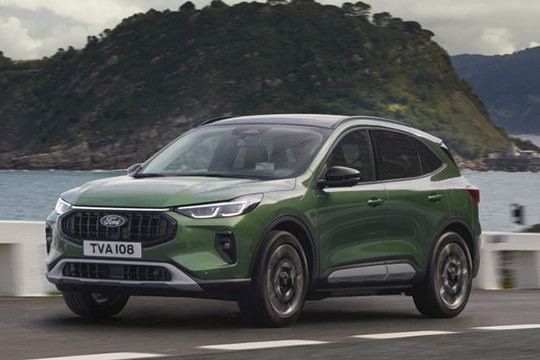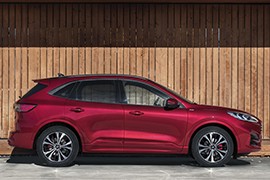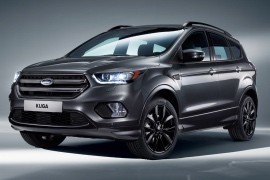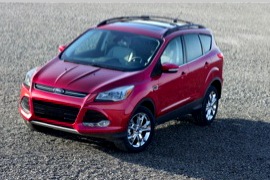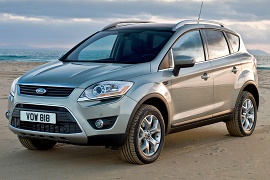FORD Kuga Models/Series Timeline, Specifications & Photos
First production year: 2008
Engines: Gasoline, Diesel
Body style: SUV (Sports Utility Vehicle)
Ford refreshed the third generation of its European compact crossover Kuga in early 2024, bringing 5G technology and other essential updates to this successful model.
Ford had an edge over its competitors in a market where customers had migrated from station wagons and minivans to crossovers and SUVs. It had vast experience in producing 4x4 vehicles and used it to stay ahead of the competition. While it didn’t lead the European market, it was ahead of others. The third generation of the Kuga came onto the market in the spring of 2019, and despite the drop in sales during the world pandemic, the crossover bounced back and became the best-selling PHEV on the European market in 2021 and 2022. As a result, to keep its customers happy and bring them back to Ford dealerships, the blue-oval brand introduced a refreshed version of the Kuga in 2024.
Along with the refresh, Ford introduced the Active trim level, which was created for those looking for a more adventurous vehicle. Even though it wasn’t a rugged off-road beast, it could still perform well on unpaved roads. The entire refreshed Kuga range received a new front fascia that featured an LED stripe that visually connected the redesigned, elongated headlights. The upper grille featured a new hexagonal pattern where the Ford logo took center stage. Lower, on the bumper, the automaker added a light-gray air intake that resembled a skid plate, even though it was made from plastic. The Active package also included a new set of side scoops that housed a set of round fog lamps. Apart from this version, the Kuga was also available in ST clothing, featuring new trims around the side scoops that channeled air around the vehicle, forming an air curtain.
From its profile, the Kuga sported black B- and C-pillars and trims around the windows. Still, the overall shape of the crossover didn’t change compared to the non-facelifted version of it, but some details made it look different. In addition, the new design for the alloy wheels and the turn signals integrated into the body-colored door mirrors looked more upscale. Finally, at the back, the 2024 Kuga featured wide taillights extended from the rear quarter panels onto the metallic part of the tailgate.
Inside, the automaker installed high-bolstered front seats for all versions. Those from the Active trim level sported an A letter embroidered on the seatbacks. On the dashboard, the automaker installed a wide touchscreen fitted with Ford’s SYNC 4 infotainment, offering 5G connectivity. Furthermore, it featured wireless Apple CarPlay and Android Auto, plus built-in Alexa. Customers could enjoy enough headroom for all seats. In addition, the rear bench seat could slide and provide over a meter (3 ft) of additional legroom for those seated in the back.
Under the hood, the 2024 Kuga was available with either mild-hybrid or plug-in hybrid versions that sent their power to the front wheels or in all corners via either a manual or an automatic transmission.
The Ford Kuga was first produced in 2008 and was also called the Ford Escape on some markets such as the U.S.
Like the Ford Focus and Ford C-Max, the Kuga is based on the C1 platform and it comes in several versions, a 1.5-liter & a 2.0-liter EcoBlue diesel, and a 1.5-liter EcoBoost gasoline engine, followed by plug-in hybrid variants, Kuga EcoBlue Hybrid (mild-hybrid) and Kuga Hybrid (full-hybrid).
The new Kuga model benefits from the latest automotive technologies and hi-tech features like Stop & Go, Speed Sign Recognition, Lane-Centring, wireless charging pad, FordPass Connect embedded modem, B&O Sound System, 12.3-inch LCD, and Ford's SYNC 3 infotainment system accompanied by an 8-inch central touchscreen. The parking can be done automatically through Active Park Assist 2, a useful technology that makes life easier for its users.
The new Ford Kuga comes with more interior space making the car more comfortable, revised aerodynamics (thus reducing weight and fuel consumption) and augmented architecture for improved crash performance. Furthermore, due to a longer wheelbase, the stability on the road has increased, and with Post-Collision Braking technology (that reduces the impact of a potential secondary collision), Ford has made the Kuga model inherently safer.
With 12 colors available, customers have a wider palette to choose from, according to their personal preferences.
The second generation of the Ford Kuga was unveiled in 2012 and it was the answer given by Ford Motor Company for the compact-class SUV. It was designed in Europe.
The first generation of Kuga was premiered at the 2007 Frankfurt Motor Show, at the same time with its main rival in Europe, the Volkswagen Tiguan. While the economic crisis started, the sales figures dropped and Ford was forced to sell its premium brands in Europe such as Volvo, Aston Martin, Land Rover, and Jaguar. Kuga and all the other cars offered by Ford had to survive and drive the car-maker ahead.
The 2017 model received a big improvement for the second generation of the Kuga. A bigger, taller, and wider grille was adopted. It was flanked by new headlamps incorporating LED daytime running lights and complemented by fog lamps. The taillights and the rear bumper were redesigned as well.
Inside, the biggest improvement was the introduction of the SYN3 infotainment unit. It was engineered to complement the modern smartphones and offered a better understanding of voice commands. The 8” touch-screen display offered a better layout. It featured a parallel or perpendicular automatic parking system.
For the drivetrain, the Ford C1 platform was perfect for the compact Kuga. Due to its architecture, it allowed both front and all-wheel-drive systems via a Haldex electronically controlled center differential. Kuga was offered with a choice of four gasoline and four diesel engines. All of them were turbocharged.
Surprisingly, the new Kuga was cheaper than its predecessor, however, it was bigger and offered more technology.
The new Kuga was also longer, improving the available space for the rear passengers. The trunk was a great size and could have became a completely flat load bay with the rear seats folded. The Kuga also featured an optional power lift gate. The backseats were also reclinable.
The cabin of the Kuga was fitted with good quality materials and the dash was similar to the one on the C-Max. The modern look was emphasised with the gloss black finish that gave a premium feeling.
The cabin offered lots of storage spaces, including a large glovebox and big side bins.
Available with a front wheel drive system or an all wheel drive system, the Kuga performed well and was grippy. The front wheel drive was more adequate for people looking to buy a car with a reduced fuel consumption.
The Kuga was equipped with Ford’s latest technology, including lane keeping assist, an optional blind spot monitoring system and an electronic anti-skid system, active city stop, auto high beam, driver alert and traffic sign recognition.
The Kuga was given a 5 star score at the Euro NCAP and it was also awarded for its Emergency Assistance system, meaning that if airbags deployment was detected, an emergency call was made and automatically provided the GPS co-ordinates.
Ford ramped up its game and introduced the Kuga crossover on the market in 2008, offering a better alternative for those looking for a hatchback-sized vehicle with the interior space of a minivan.
Customers started to understand the advantages of crossovers and moved away from the minivan segment. These vehicles provided enough interior room for a family with kids, bicycles, trampolines, special seats, and many other luggage while still being able to park in tight spots where just regular hatchbacks could fit. Ford had wide experience in building off-road vehicles and compact-sized cars. As a result, it mixed them and introduced the Kuga in 2008, a crossover that it produced on the same platform as the second generation of the Ford Focus.
When Ford designers were tasked with this mission, they tried to replicate the same design language of the Focus and the Mondeo. As a result, the headlights featured a similar shape to the headlights and the three-slat grille adorned by a chromed trim above it. Still, that led to a taller front bumper to cover all the lower side of the front fascia, where the automaker installed an additional trapezoidal-shaped grille and two side scoops that flanked it and sported the fog lamps. From its profile, the Kuga resembled the five-door Focus greenhouse, with a third row of windows mounted between the C-pillars and the tailgate. Still, they had to install taller door panels since the car had to be taller. At the back, the automaker installed light-gray plastic shields under the bumper and flanked it with two exhausts.
Inside, the Kuga featured high-mounted seats to help drivers get a better view of the road. They also got an instrument cluster similar to that installed in the Focus and a tilted-forward center stack adorned with a light-gray trim. The engineers, then, had to find a solution to place the gear stick higher so the drivers feel like in regular hatchbacks. As a result, between the front occupants was a tall center console that housed a pair of cup holders neatly concealed under a sliding cover. In the back, thanks to the tall seating position, there was enough legroom for three passengers with a low transmission tunnel. The split-folding (60/40) bench seat offered customers the possibility to expand the trunk space from 360 liters (12.7 cu-ft.) to 1,370 liters (47.8 cu-ft). That was a massive difference.
But Ford played it even smarter and offered the Kuga with either all-wheel drive or front-wheel drive systems. Thanks to its experience in the American market, it knew that most of the time, customers drove their vehicles on dry or wet roads, not on snowy ones. But thanks to its European experience, it also knew that buyers from the Old Continent were leaning toward diesel engines. As a result, it offered the Kuga with either front- or all-wheel drive systems, a wide range of turbo-diesel powerplants, and manual or automatic transmissions. In addition, a 2.5-liter naturally-aspirated powerplant completed the engine lineup for those who didn’t want an oil-burner vehicle.
